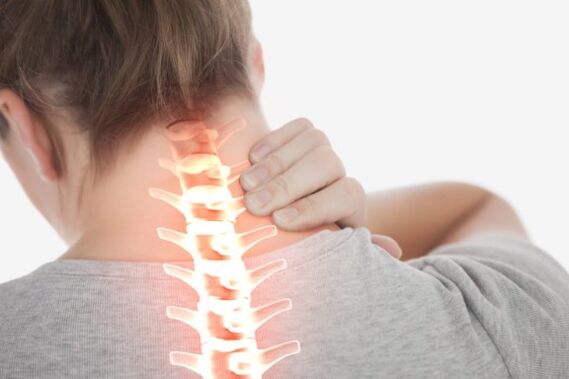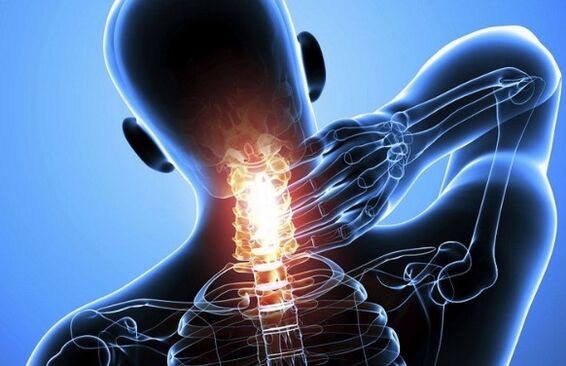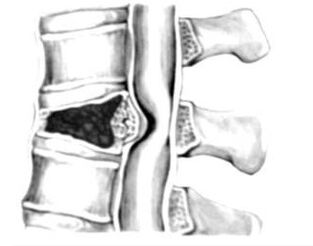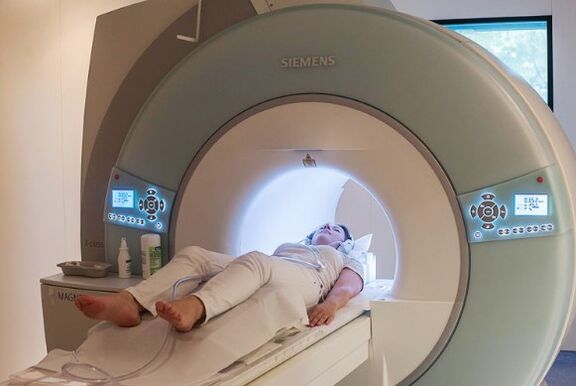Osteochondrosis is a serious degenerative-dystrophic destruction of cartilage tissue located between vertebral vertebrae. In this pathological phenomenon, the disc itself is affected, their height changes, damaged bone tissue in the cervix.Pathology has the same symptoms as some diseases. The main thing is to see the first signal of the body in time and to undergo diagnostic with the necessary treatment, otherwise osteochondrosis will begin to develop, causing migraines, and blood circulation disorders. Basically, pathology develops in people who have reduced motor activity. This is due to the fact that the exchange of mineral salts in the body is disrupted, which causes depletion of connective tissue, as well as decreased strength.

The factor of causing the disease occurs
The neck is the most portable part of the body, so it has a constant burden, as it is required to hold the head in a certain position. Some factors can negatively affect this area and develop the inflammation process in the connective tissue.
The cause of the development of pathological deviation in the cervical vertebra is:
- non -compliance with power rules, which is why overweight;
- functional changes in the skeletal muscle system;
- hypodynamia;
- injury to the neck or spinal column;
- excessive physical pressure on the spinal column;
- pressure;
- Physical length voltage from cervical muscle frame;
- descendants;
- Anomalies in bone development.
All of these factors have a negative effect on the cervical region vertebra, which creates stress, leading to the reduction of smooth muscle and skeletal tonic. Which leads to the formation of hemodiscilative processes, moisture of metabolic function, development of dysfunction and degenerative changes in cartilage. Vertebra begins to shape, acquire non -standard shapes, and often go beyond the spinal column.
Symptoms of disease
The early stages of the pathological process are clearly visible by some signs.
- Cephalgic syndrome. It is formed during cerebral angiospasm, squeeze the cerebrospinal cerebrospinal nerve, and against the voluntary intracranial hypertension background. It spreads through the occipital part of the head, neck, which affects the shoulder and upper limbs. Pain syndrome can resemble prolonged increased blood pressure (hypertension), angina pectoris attack, violation of cerebral circulation, and manifest in the form of paroxysmal, constant or pulsating properties. Anxiety can increase, mood changes arise, attention concentration decreases, a person becomes angry, sensitive;
- dizziness occurred, coordination of disturbed movement. Everything is accompanied by tinnitus, nausea, vomiting, disorientation. It is not necessarily a sign of this pathology, as it can be clear as a result of an average or internal media otitis, heart disease, cerebral angiospasm or impaired nerve cell function. Also, dizziness is often observed with vestibular disorders;

IMPORTANT!There are two types of dizziness. With non -systematic dizziness, the disadvantages appear, amazing, it is difficult for a person to be in a straightforward position. But at the same time, the object that falls into the view does not rotate. And systemically, circular movements of all objects are shown, which indicates violations of vestibular apparatus work, visual perception, muscle cramps. This is a distinctive sign of dizziness for osteochondrosis.
- painful manifestations in the neck. The sensation of pain is localized not only in muscle tissue, but also on the shoulders, including the upper limbs. The occurrence of pain develops suddenly and lasts a long time, and may have a short period of time. If the disease does not turn relapse, then the pain goes away after a while, while there will be a little special sound (crisis);
- Arterial hypertension. When pinching the nerve end, a sharp jump in blood pressure occurs. Therefore, if increased pressure is observed for a long time, this is not a symptom of osteochondrosis. High pressure in the disease is combined with cephalgia, pain in the hand, chest compression, cervical area of the cervix behind its sensitivity. Weaknesses, fatigue, lack of strength in the upper limbs.
Table. Classification of osteochondrosis of the cervical area.
| Phase | Feature |
|---|---|
| 1 degree | Neck lordosis is slightly smooth. The occurrence of pain, increasing when moving the head. The emergence of tense conditions and weakness in the lumbar region. |
| 2 degrees | There is a decrease in the size of the fibrous and chrysiak formation, compressing the nerve branch. The pain is transmitted to the shoulders, hands, increasing when moving the neck. Cephalgic syndrome, fatigue, disruption, developing, and performance are reduced. |
| 3 degrees | Persistent pain sensation at the top, cervical hotel and shoulders. There is muscle weakness, numbness of the body. The intervertebral disc hernia is formed. The neck is inactive, vertigo appears. |
| 4 degrees | Fibrous formation and chrysline are destroyed. Connect fibers replace the destroyed cartilage. The simultaneous destruction process can affect more than one segment of the vertebra. Patients are truly confused, pain and increased vertigo. |
What is the danger of the disease?

Pathology harms the whole human body. With osteochondrosis, blood vessels, nerve roots are strictly maintained, leading to encephalopathy being disabled, cephalgic syndrome develops, heart rhythm pathology, visual, respiratory system, concentration and coordination processes.
The disease tends to cause:
- various brain pathology;
- some vascular, vascular, vegetative natural disorders;
- Acute violation of spinal circulation with ischemic or bleeding (spinal stroke).
Diagnostics
How to diagnose an intervertebral disc violation.
- Radiography. It is not effective enough in the last stage of the disease.
- Magnetic resonance tomography (MRI). The research method, which brings detailed information on the presence of deviations, pathology of bone structure, connective tissue, whether there is a hernia, with its size, location and growth explanation.
- Computer tomography uses contrast. Allows you to determine the pathology in the vertebra. The disadvantage of such studies is that it is impossible to determine the presence of spinal cord compression.
- Ultrasound Dopplerography. The effectiveness of this method is to determine the reduction of blood circulation through the blood vessels.
Characteristics of treatment
In the treatment of osteochondrosis of the cervical area, they are based on the level of the disease, manifestations and clinical forms of the features. Treatment can be carried out as:
- Non -Kurik Therapy, the purpose is to eliminate symptoms, manifestations of disease to reduce the condition of the patient using drugs and physiotherapy, therapeutic training, massage;
- surgical intervention;
- Coalition. In this method, surgical intervention is carried out with further treatment with medication.

After the diagnostic examination, the specialist makes a final diagnosis and prescribes the required treatment depends on the clinical picture of the disease. Basically, if the disease is at a stage that does not require surgery, complex therapy is prescribed, including taking medication, therapeutic training performance and a healing massage course path.
Medication
Doctors prescribe medications aimed at eliminating symptoms of pain, focus of inflammation and muscle tension, restoring cartilage tissue, increasing the body with a vitamin-mineral complex in the form of capsules, injections, ointments.
Therapeutic physical culture (training therapy)
Medical physical education is set to restore blood circulation in the cervical region. Movement should not be sharp, with excessive rotation or head bending. It is necessary to mimic the movement listed. Exercise is done no more than two minutes. Training treatment complexes include head tilt forward and backward, without acting until the end.
Basic exercises used to treat osteochondrosis.
- Pose "lying down" in the stomach received. The hands rest on the floor, and the head and trunk rise. The back remains straight. It should be in this position for about two minutes in a 2-3 approach.
- Pose "lying down" in the stomach received. Hands stretch throughout the body. The head is made to the right and left, trying to touch the floor with the ear. 6-7 Approach to each side.
- Pose "Sit" is received. With inhalation, forward tilt, while trying to stretch to the chest with his head. When you breathe, return to its original position, with a slight back slope. 10-15 Approaches are taken.
- In the "sitting" pose, the palm of the hand is applied to the forehead, while making an urgent movement. The head also reaches the palm of the hand, creating a resistance effect. 2-3 approaches 30 seconds are done.
- The movement of the head of the headthat is done very carefully and slowly to the right and left. Ten movements are made in each direction, avoiding dizziness.
Therapeutic massage
In the treatment of osteochondrosis, specialists make massage movements in the cervical region, collar area, and upper back. This procedure must be performed in a lying position so that the patient's body is relaxed.
The main technique of therapeutic massage:
- Favorable- The technique in which large hands slide around the skin with a small level of pressure, capture the base area and move to the upper back.
- Squeeze- Techniques where stronger effects on the skin, subcutaneous tissue and muscle surface layers are performed. The skin with the fingers occurs carefully, intercepting the fabric.
- Trituration- It consists of the transition and stretching of tissue in various directions to heat the skin and blood flow to the collar area.
- Knead- The most difficult technique that affects deep muscle tissue. It is only performed on the recommendation of a doctor, carefully, as it can lead to complications of the disease.

Physiotherapy treatment method
For the treatment of the pathology of the intervertebral disk of the cervical region, physiotherapy is prescribed.
- Drug electrophoresis-Physiotherapeutic ultrasonic procedures performed under sinusoidal modulated current.
- Laser therapy- These are physiotherapy methods, which activate blood circulation, eliminate inflammation, reduce pain. Laser therapy is performed to improve blood flow.
- Magnetotherapy- One of the methods based on the treatment of magnetic field exposure, with the influence of tissue edema removed and the pain is eliminated.
- Ultrasound therapy- Treatment allows you to relieve pain, inflammation, while improving blood circulation.
Traditional medicine in the treatment of cervical spinal osteochondrosis
People's methods for treating osteochondrosis will not work. This is due to the fact that this method can relieve the symptoms of temporary, but does not solve the main problem - the effects of the initial destruction of the spinal column. At home, plant components can be used as a supportive complex for major therapeutic treatments established by doctors.
For pain in the cervical region, you can use:
- Flying leaves (treated with boiling water, used to focus on pain);
- Raw potatoes and honey (potatoes are rubbed until the hereses are formed, mixed with honey in the same proportion and are used for inflammation at least once a week);
- Mustard, pepper patches and rubbing with alcohol (used for local irritation, increased blood circulation and removal of pain).

Precaution
To prevent one of the dangerous diseases, it is necessary to adhere to certain rules throughout your life. Following the right lifestyle can be prevented by many diseases. However, there are situations when the disease is inherited, and then it should be noted to your health. Nutrition is enriched with vitamins and minerals, as well as moderate physical activity will help maintain the body and also stop the development of the initial disease.
A doctor's recommendation that will help prevent the appearance of the disease:
- leading an active lifestyle, engaging in swimming;
- Note the right nutrition;
- eat foods with calcium, magnesium (seafood, legumes, dairy products, vegetables);
- Every day performs physical warmth, especially if work is associated with continuous sitting position;
- Use special orthopedic pillows and mattresses for sleeping.
At any age, with osteochondrosis, it is worth regularly conducting body examination, as well as performing therapeutic physical culture with normal massage, then with your illness you can live for a long time and comfort.


















